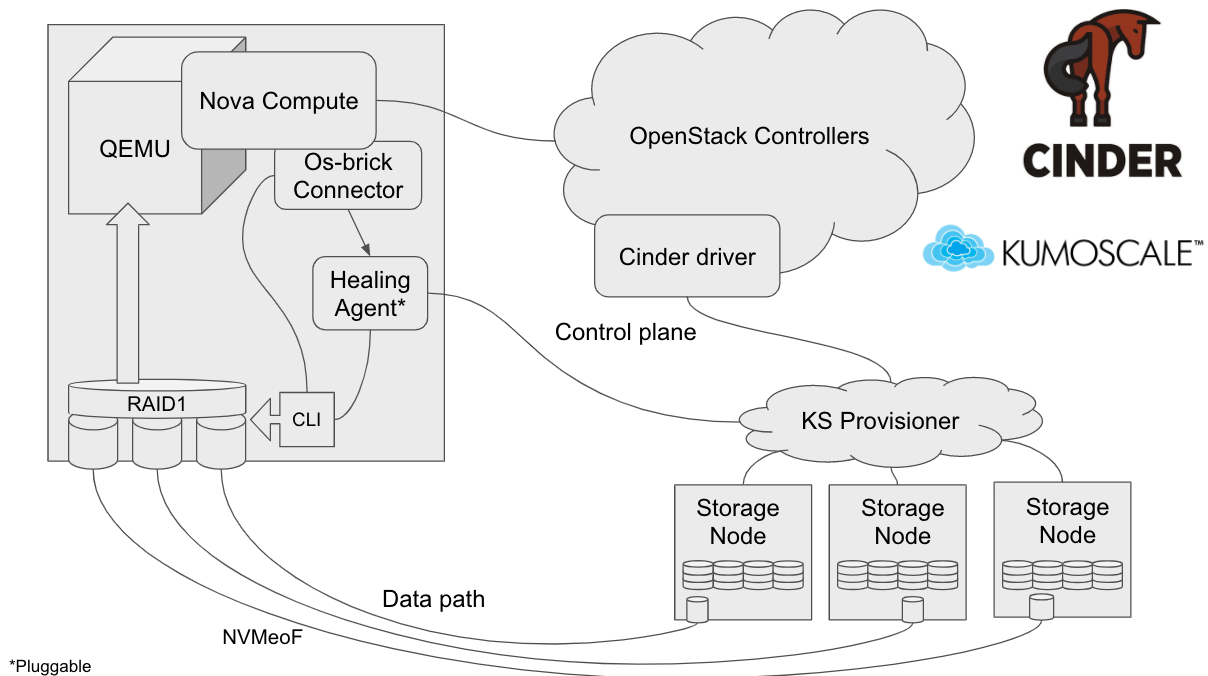NVMe Connector Support MDRAID replication¶
https://blueprints.launchpad.net/cinder/+spec/nvme-of-add-client-raid-1
NVMe connector replicated volume support via MDRAID. Allow OpenStack to use replicated NVMe volumes that are distributed on scale-out storage.
Problem description¶
When consuming block storage, resilience of the block volumes is required. This can be achieved on the storage backend with NVMe and iSCSI though the target will remain a single point of failure. And with multipathing, the HA of paths to a target does not handle volume data replication.
A storage solution exposing high performance NVMeoF storage would need a way to handle volume replication. We propose achieving this by using RAID1 on the host, since the relative performance impact will be less significant in such an environment and will be greatly outweighed by the benefits.
Use Cases¶
When resiliency is needed for NVMeoF storage.
Taking advantage of NVMe over a high performance fabric, gain benefits of replication on the host while maintaining good performance.
In this case volume replica failures will have no impact on the consumer, and will allow for self healing to take place seamlessly.
For developers of volume drivers, this will allow support for OpenStack to use replicated volumes that they would expose in their storage backend.
End users operating in this mode will benefit from performance of NVMe with added resilience due to volume replication.
Proposed change¶
Expand the NVMeoF connector in os-brick to be able to take in connection information for replicated volumes.
When connect_volume is called with replicated volume information, NVMe connect to all replica targets and create a RAID1 over the devices.

Alternatives¶
Replication can also be actively maintained on the backend side, which is the way it is commonly done. However, with NVMe on a high performance fabric, the benefits of handling replication on the consumer host can outweigh the performance costs.
Adding support for this also increases the type of backends we fully support, as not all vendors will chose supporting replication on the backend side.
And we can support both without any kind of impact on each one.
Data model impact¶
NVMe Connector’s connect_volume and disconnect_volume param connection_properties can now also hold a volume_replicas list, which will contain necessary info for connecting to and identifying the NVMe subsystems for then doing MDRAID replication over them.
Each replica dict in volume_replicas list must include the normal flat connection properties.
If volume_replicas has only one replica, treat it as non-replicated volume.
If volume_replicas is ommitted, use the normal flat connection properties for NVMe as in the existing version of this NVMe connector.
non-replicated volume connection properties:
{'uuid': '96e25fb4-9f91-4c88-ab59-275fd354777e',
'nqn': 'nqn.2014-08.org.nvmexpress:uuid:...'
'portals': [{
'address': '10.0.0.101',
'port': '4420',
'transport': 'tcp'
}],
'volume_replicas': None}
replicated volume connection properties:
{'volume_replicas': [
{'uuid': '96e25fb4-9f91-4c88-ab59-275fd354777e',
'nqn': 'nqn.2014-08.org.nvmexpress:uuid:...'
'portals': [{
'address': '10.0.0.101',
'port': '4420',
'transport': 'tcp'
}]},
{'uuid': '12345fb4-9f91-4c88-ab59-275fd3544321',
'nqn': 'nqn.2014-08.org.nvmexpress:uuid:...'
'portals': [{
'address': '10.0.0.110',
'port': '4420',
'transport': 'tcp'
}]},
]}
REST API impact¶
None
Security impact¶
Requires elevated priviliges for managing MDRAID. (Current NVMe connector already does sudo executions of nvme cli, so this change will just add execution of mdadm)
Active/Active HA impact¶
None
Notifications impact¶
None
Other end user impact¶
Working in this replicated mode will allow for special case scenarios where for example a MDRAID array with 4 replicas loses connection to two of the replicas, keeps writing data to two remaining ones. Then, after a re-attach from a reboot or a migration, for some reason now has access to only the two originally lost replicas, and not the two “good” ones, then the re-created MDRAID array will have old / bad data.
The above can be remedied by storage backend awareness of devices going faulty in the array. This is enabled by the NVMe monitoring agent, which can recognize replicas going faulty in an array and notify the storage backend, which will mark these replicas as faulty for the replicated volume.
Multi attach is not supported for NVMe MDRAID volumes.
Performance Impact¶
Replicated volume attachments will be slower (need to build MDRAID array). It’s a fair tradeoff, slower attachment for more resiliency.
Other deployer impact¶
NVMe and MDRAID and their CLI clients (nvme and mdadm) need to be available on the hosts for NVMe connections and RAID replication respectively.
Developer impact¶
Gives option for storage vendors to support replicated NVMeoF volumes via their driver.
To use this feature, volume drivers will need to expose NVMe storage that is replicated and provide necessary connection information for it when using this feature of the connector.
This would not affect non-replicated volumes.
Implementation¶
Assignee(s)¶
- Zohar Mamedov
zoharm
Work Items¶
All done in NVMe connector:
In connect_volume parse connection information for replicated volumes.
Connect to NVMeoF targets and identify the devices.
Create MD RAID1 array over devices.
Return symlink to MDRAID device.
disconnect_volume destroy the MDRAID.
extend_volume grow the MDRAID.
Dependencies¶
NVMe and MDRAID and their CLI clients (nvme and mdadm) need to be available on the hosts for NVMe connections and RAID replication respectively. Fail gracefully if they are not found.
Testing¶
In order to properly test this in tempest, programmatic access will be needed to the storage backend. For example, to fail one of the drives of a replicated volume.
We could also slide by with just a check of connected NVMe subsystems (nvme list) and scan of MDRAID arrays (mdadm -D scan) to see that multiple NVMe devices were connected and a RAID was created.
In either case tempest will need to be aware that the storage backend is configured to use replicated NVMe volumes and only then do these checks.
Aside from that, running tempest with NVMe replicated volume backend will still fully test this functionality, it’s just the specific assertions (nvme devices and RAID info) that would be different.
Finally, we will start with unit tests, and have functional tests in os-brick as a stretch goal.
Documentation Impact¶
Document that NVMe connector will now support replicated volumes and that connection information of replicas is required from the volume driver to support it.
References¶
Architectural diagram https://wiki.openstack.org/wiki/File:Nvme-of-add-client-raid1-detail.png
